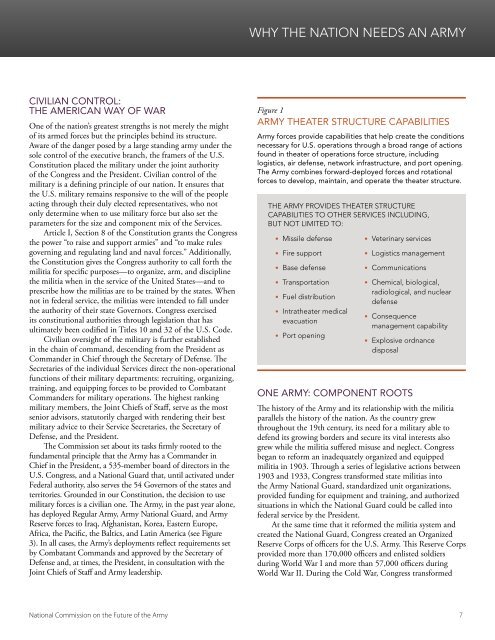THE FUTURE OF THE ARMY
Futurearmy
Futurearmy
Create successful ePaper yourself
Turn your PDF publications into a flip-book with our unique Google optimized e-Paper software.
WHY <strong>THE</strong> NATION NEEDS AN <strong>ARMY</strong><br />
CIVILIAN CONTROL:<br />
<strong>THE</strong> AMERICAN WAY <strong>OF</strong> WAR<br />
One of the nation’s greatest strengths is not merely the might<br />
of its armed forces but the principles behind its structure.<br />
Aware of the danger posed by a large standing army under the<br />
sole control of the executive branch, the framers of the U.S.<br />
Constitution placed the military under the joint authority<br />
of the Congress and the President. Civilian control of the<br />
military is a defining principle of our nation. It ensures that<br />
the U.S. military remains responsive to the will of the people<br />
acting through their duly elected representatives, who not<br />
only determine when to use military force but also set the<br />
parameters for the size and component mix of the Services.<br />
Article I, Section 8 of the Constitution grants the Congress<br />
the power “to raise and support armies” and “to make rules<br />
governing and regulating land and naval forces.” Additionally,<br />
the Constitution gives the Congress authority to call forth the<br />
militia for specific purposes—to organize, arm, and discipline<br />
the militia when in the service of the United States—and to<br />
prescribe how the militias are to be trained by the states. When<br />
not in federal service, the militias were intended to fall under<br />
the authority of their state Governors. Congress exercised<br />
its constitutional authorities through legislation that has<br />
ultimately been codified in Titles 10 and 32 of the U.S. Code.<br />
Civilian oversight of the military is further established<br />
in the chain of command, descending from the President as<br />
Commander in Chief through the Secretary of Defense. The<br />
Secretaries of the individual Services direct the non-operational<br />
functions of their military departments: recruiting, organizing,<br />
training, and equipping forces to be provided to Combatant<br />
Commanders for military operations. The highest ranking<br />
military members, the Joint Chiefs of Staff, serve as the most<br />
senior advisors, statutorily charged with rendering their best<br />
military advice to their Service Secretaries, the Secretary of<br />
Defense, and the President.<br />
The Commission set about its tasks firmly rooted to the<br />
fundamental principle that the Army has a Commander in<br />
Chief in the President, a 535-member board of directors in the<br />
U.S. Congress, and a National Guard that, until activated under<br />
Federal authority, also serves the 54 Governors of the states and<br />
territories. Grounded in our Constitution, the decision to use<br />
military forces is a civilian one. The Army, in the past year alone,<br />
has deployed Regular Army, Army National Guard, and Army<br />
Reserve forces to Iraq, Afghanistan, Korea, Eastern Europe,<br />
Africa, the Pacific, the Baltics, and Latin America (see Figure<br />
3). In all cases, the Army’s deployments reflect requirements set<br />
by Combatant Commands and approved by the Secretary of<br />
Defense and, at times, the President, in consultation with the<br />
Joint Chiefs of Staff and Army leadership.<br />
Figure 1<br />
<strong>ARMY</strong> <strong>THE</strong>ATER STRUCTURE CAPABILITIES<br />
Army forces provide capabilities that help create the conditions<br />
necessary for U.S. operations through a broad range of actions<br />
found in theater of operations force structure, including<br />
logistics, air defense, network infrastructure, and port opening.<br />
The Army combines forward-deployed forces and rotational<br />
forces to develop, maintain, and operate the theater structure.<br />
<strong>THE</strong> <strong>ARMY</strong> PROVIDES <strong>THE</strong>ATER STRUCTURE<br />
CAPABILITIES TO O<strong>THE</strong>R SERVICES INCLUDING,<br />
BUT NOT LIMITED TO:<br />
• Missile defense<br />
• Fire support<br />
• Base defense<br />
• Transportation<br />
• Fuel distribution<br />
• Intratheater medical<br />
evacuation<br />
• Port opening<br />
• Veterinary services<br />
• Logistics management<br />
• Communications<br />
• Chemical, biological,<br />
radiological, and nuclear<br />
defense<br />
• Consequence<br />
management capability<br />
• Explosive ordnance<br />
disposal<br />
ONE <strong>ARMY</strong>: COMPONENT ROOTS<br />
The history of the Army and its relationship with the militia<br />
parallels the history of the nation. As the country grew<br />
throughout the 19th century, its need for a military able to<br />
defend its growing borders and secure its vital interests also<br />
grew while the militia suffered misuse and neglect. Congress<br />
began to reform an inadequately organized and equipped<br />
militia in 1903. Through a series of legislative actions between<br />
1903 and 1933, Congress transformed state militias into<br />
the Army National Guard, standardized unit organizations,<br />
provided funding for equipment and training, and authorized<br />
situations in which the National Guard could be called into<br />
federal service by the President.<br />
At the same time that it reformed the militia system and<br />
created the National Guard, Congress created an Organized<br />
Reserve Corps of officers for the U.S. Army. This Reserve Corps<br />
provided more than 170,000 officers and enlisted soldiers<br />
during World War I and more than 57,000 officers during<br />
World War II. During the Cold War, Congress transformed<br />
National Commission on the Future of the Army 7


